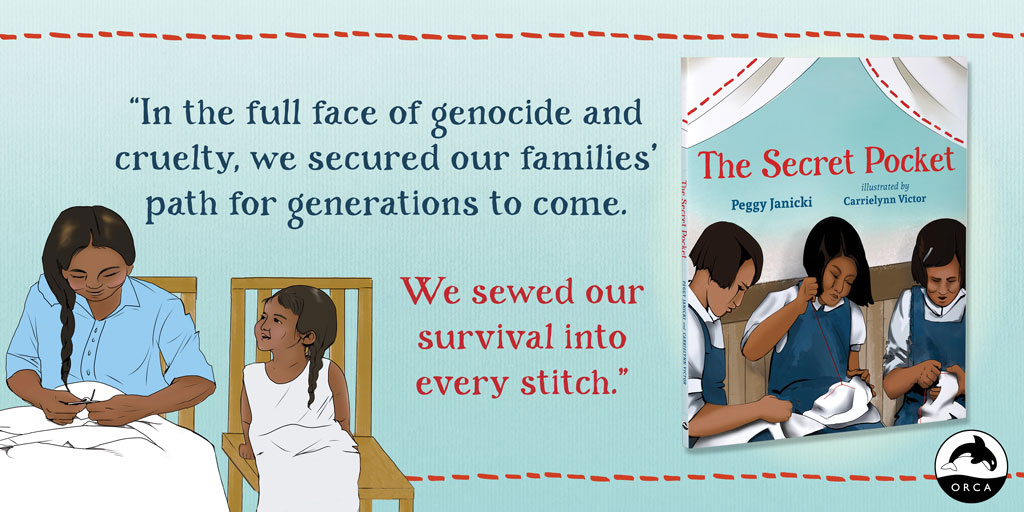“Though the tale is emotionally fraught, young readers are left with an uplifting reminder about the power and resolve of Indigenous people…A moving tribute to Native children’s survival in the residential school system.”
Kirkus Reviews
Based on author Peggy Janicki’s mother’s experience at residential school, The Secret Pocket is a story of survival and resilience in the face of genocide and cruelty. It’s also a celebration of quiet resistance to the injustice of residential schools and how the sewing skills passed down through generations of Indigenous women gave these girls a future, stitch by stitch.
In this article, Peggy Janicki answers questions about her debut picture book The Secret Pocket.
- The Secret Pocket tells of how your mother, Mary, survived the Lejac residential school. What inspired you to share her story?
I have been teaching about Indian Residential School for over twenty years and have been sharing her story for many years prior to the children’s book. So, inspiration came from my sense of responsibility to the story and constant encouragement from my husband, Rick Joe. With my mother’s permission, she allowed me to share the story in many classrooms.
- For several years now, this story has been gifted to Indigenous graduates from the University of the Fraser Valley and now to even more students. Can you tell us more about that initiative?
The idea came when I was teaching new Teacher Candidates at the University of Fraser Valley (UFV). I am always honoured when Teacher Programs ask me to teach a role-drama Indigenous history lesson they can use in classrooms. So, it was one of these sessions when the request came to use the story. I had to ask my mother if they can use the story; her response was, “Well, they gotta know”. From there, UFV created beautiful hand-sewn graduation stoles with a pocket in it and in that pocket is a shortened version of my mother’s story. They also asked Dr. Elizabeth Phillips to create and place a Halq’eméylem name on the pocket, Mi’emhoelh. June 2019, UFV thanked my mother and Dr. Elizabeth Phillips in a ceremony (found here, in a Chilliwack Progress news article). Sadly, at that time my mother had passed away, so, I stood in for her.
- What does it mean to “gift a story” and how does that help ensure that it will live on?
Gifting stories involves knowing the credit/citation, consent, responsibilities, respect and accountability. Some stories have directions to not be written and many need to be cited. So, depending on the story being gifted, stories have responsibilities.
- You have been sharing this important story for many years, how did you decide to make it into a picture book?
That decision was my husband’s. He has ALWAYS encouraged me to make the story into a book and I always shied away from writing a book. So, he has full credit for that decision.
- Your mother and the other girls at the residential school used the sewing skills passed down by their mothers, aunties and grandmothers to create the secret pockets. Did your mother share these sewing skills with you?
Yes, she showed me how to use two threads to bead moccasins. Also, I shall always treasure a time my Auntie Catherine and I spent sewing beautiful flower beadwork onto a large hide.
- What was it like working with illustrator Carrielynn Victor? Do you have a favorite illustration or spread from the book?
It was an honour and pleasure working with Carrielynn. I am a huge fan of artists and appreciate the artistic process. So, I loved watching the art come to life. Yes, I have three favourite spreads of the book. The first is where my mother is cuddled with her grandmother in the smokehouse; the second, is where my mother is waiting for ‘Uba and she is looking out the window; and, the third is the last page where my mother is reflecting as a great-grandmother. The pictures of ‘Uba are from family photographs and always take my breathe away. Also, the picture of my mother on the last spread is a picture of my grandmother. My mother and grandmother look very similar, as I do of them.
- What do you hope readers will gain from reading your book?
My hope is to highlight Indigenous agency and genius within Indigenous sovereignties, in their many forms. We continue to amplify our adaptability to weather the storm of genocide in Canada. Also, I hope readers see our strengths and recontextualize our strength when they reflect back in time.

Peggy Janicki is an award-winning Dakelh teacher from the Nak’azdli Whut’en First Nation. She holds a master of education in Indigenous knowledges/Indigenous pedagogies from the University of British Columbia. Peggy has worked for decades to reveal the hidden stories and histories of Indigenous Peoples, as featured in UBC’s Massive Open Online Course (MOOC) “Reconciliation through Indigenous Education.” When her mother shared a secret story that changed all their lives and highlighted the impacts of colonization, Peggy also became a storyteller. She lives in Chilliwack, British Columbia.
Photo by Gracie Kelly (Soowalie First Nation)

